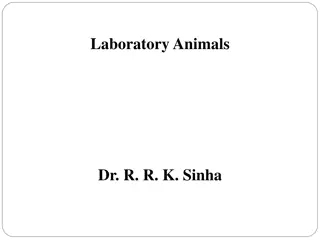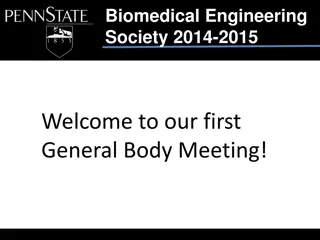Training Module on Laboratory Animals in Biomedical Research
This training module focuses on the utilization of laboratory animals in biomedical research, covering various species such as rodents, rabbits, birds, amphibians, and more. It emphasizes understanding different animal models, controlling experimental variables, and outlining responsibilities within research projects. The content delves into the relevance, goals, and types of animal models used in this field, providing valuable insights for animal users working in vivaria settings.
Download Presentation

Please find below an Image/Link to download the presentation.
The content on the website is provided AS IS for your information and personal use only. It may not be sold, licensed, or shared on other websites without obtaining consent from the author. Download presentation by click this link. If you encounter any issues during the download, it is possible that the publisher has removed the file from their server.
E N D
Presentation Transcript
CCAC TRAINING MODULE ON: LABORATORY ANIMALS USED IN BIOMEDICAL RESEARCH www.ccac.ca
Relevance of this Training Module This training module is relevant to all animal users working with animals housed in vivaria (enclosed areas such as laboratories) in biomedical research This training module covers the following animals housed in vivaria: rodents rabbits birds amphibians reptiles non-human primates other mammals Photo courtesy of Dr. S.Craig 2
Training Module Goals Understand the differences in the types of animal models used in biomedical research and the importance of their selection Recognize the importance of accounting for and controlling the variables in the experimental design Develop a checklist of the variables that can affect research programs Describe and accept responsibility for ensuring the successful conduct of an experiment 3
Training Module Outline Use and selection of animal models in biomedical research Variables influencing the response of an animal model to an experiment: animal related factors physical and environmental factors husbandry, animal care and handling factors experimental manipulation factors Responsibilities of team members involved with a research project: principal investigator graduate students, post-doctoral students and research technicians facility manager animal care staff laboratory animal veterinary staff 4
Animal Models Used in Biomedical Research Animal models are used in biomedical research to study: biology behaviour spontaneous or induced pathological processes phenomenon that resembles those in humans 5
Types of Animal Models Used in Biomedical Research 1. Spontaneous or natural models naturally occurring animal disease/condition that corresponds to the same disease/condition in humans (ie., diabetes, arthritis) 2. Experimental models disease/condition is reproduced by the investigator (ie., cancer, stroke) 6
Types of Animal Models Used in Biomedical Research 3. Genetically-engineered models manipulation of animal s genetic code to produce the disease/condition 4. Negative models animals that are resistant to a particular disease/condition 5. Orphan models animal disease/condition for which there is no known human counterpart 7
Choosing an Appropriate Animal Model REPLACEMENT Consideration of non-animal alternatives or animals with lower sentience Before an animal model is chosen, investigators must consider alternatives to the use of live animals (Three Rs) REDUCTION Using appropriate animal models and numbers to minimize variation and number of animals required REFINEMENT modification of husbandry or experimental procedures to minimize pain and distress, and enhance animal welfare Investigators must consider all factors when selecting the best model for research See the CCAC training module on: the Three Rs of humane animal experimentation (2003) and visit the CCAC Three Rs microsite at www.ccac.ca/en/alternatives for further information on this topic 8
Factors that Influence Animal Research Husbandry, Animal Care & Handling Factors Research Manipulation Factors Time and Duration of Manipulation Animal Stress Physical & EnvironmentalFactors Room Bedding Temperature Animal RelatedFactors Transportation Stress Age, Sex, Reproductive Status Experimental Stressors Disease Relative Humidity Feed and Water Genetic Make-up Microbial Flora Photo courtesy of Dr. S.Craig BiologicalRhythms Pain Ventilation Noise Housing Stress Lighting 9
Non-Experimental Factors that Influence Animal Research The non-experimental factors that can influence the response of the animal model (and affect the outcome of the study) can be grouped as: animal related factors physical and environmental factors husbandry, animal care and handling factors research manipulation factors Photo courtesy of Dr. S.Craig 10
Animal Related Factors 1. Age, sex and reproductive status responses vary with age and gender of animal hormone and physiological variations can also influence responses of females and males 2. Genetic make-up inbred (genetically identical) vs. outbred genetic manipulation can affect phenotype 12
Animal Related Factors 3. Microbial flora most animals carry microbes that can be a source of variability in research 4. Biological (circadian) rhythms metabolism varies with time of day ie., rodent metabolic rates are higher at night they can cause drugs to have variable effects depending on time of day they are administered important to perform manipulations at the same time of day for all animals 13
Animal Related Factors 5. Disease Clinical disease: disease is apparent in the animal Subclinical disease: animal appears healthy despite presence of infectious organisms Photo courtesy of Dr. J. Gourdon Photo courtesy of Dr. J. Gourdon Fur mite infestation in a mouse Immune deficient or immune compromised models are very susceptible to ordinarily non-pathogenic organisms How can you be sure that this rabbit is not harbouring a virus, bacteria or parasite that will interfere with your research results? See the CCAC training module on: infectious diseases (2010) for further information on this topic 14
Physical & Environmental Factors See Chapter III The Environment, Guide to the Care and use of Experimental Animals Vol. 1 (2nd Ed.) 1993 for further information on this topic 15
Physical & Environmental Factors 1. Room temperature temperature variations can cause changes in: behaviour (huddling, shivering) metabolic rate (higher food consumption for body heat production) temperature fluctuations should be: monitored limited to +/- 2 C as these changes can affect metabolic processes including drug metabolism 16
Physical & Environmental Factors 2. Relative humidity (RH) RH can affect : thermoregulation food consumption activity level disease transmission Prolonged low levels of RH can cause ringtail in young, unweaned rats and result in respiratory irritation most species do well with RH levels between 40 and 60% level should be appropriate for species and kept consistent (+/- 5%) 17
Physical & Environmental Factors 3. Ventilation animal housing requires high air exchange rates to remove heat, ammonia, carbon dioxide and airborne particles 4. Lighting day/night cycle consistent diurnal rhythms are necessary intensity of lights light intensities of greater than 300 lux can cause retinal damage to albino rodents wavelength influences organ weights and estrus cycle length in mice 18
Physical & Environmental Factors 5. Noise May induce seizures in young rodents and can affect: food and water consumption reproduction blood pressure immune response white blood cell count plasma cholesterol levels learning abilities 19
Physical & Environmental Factors 6. Feed and water animals should be given a consistent and reproducible diet that meets nutritional needs provided with water to meet the standards set for human consumption 7. Bedding regular bedding materials should be provided to animals 20
Husbandry, Animal Care & Handling Factors See Chapter II LaboratoryAnimal Facilities, Guide to the Care and use of Experimental Animals Vol. 1 (2nd Ed.) 1993 for further information on this topic 21
Husbandry, Animal Care & Handling Factors 1. Transportation animals should be allowed sufficient time to acclimate to the research facility upon arrival a minimum of one week is recommended 2. Housing caging space per animal and number of animals per cage should remain consistent within a study significant differences in temperature, humidity and air quality, noise and vibration levels between different types of cages 22
Husbandry, Animal Care & Handling Factors 2. Housing (continued) environmental enrichment can improve animal well-being should be uniformly and consistently provided for the duration of the experiment Hammocks can be used in cages to make them more interesting and stimulating to ferrets Toys and chewable objects allow the expression of species-typical postures and activities See the CCAC training module on: environmental enrichment (2003) and the CCAC Three Rs microsite at www.ccac.ca/en/alternatives for further information on this topic 23
Husbandry, Animal Care & Handling Factors 3. Routine care, husbandry and handling all animals should be handled the same way at the same time of day if not possible, randomize design handling must be gentle and consistent to minimize variability the kind of handling an animal receives may alter behaviour or physiology, thereby affecting its response in a study 24
Experimental Manipulation Factors 1. Time and duration of manipulation efforts should be made to: take repeated samples as the same time of day everyday keep duration of manipulation consistent 2. Experimental stressors familiarizing an animal to manipulation before a project starts is important to reduce stress It is recommended that Standard Operating Procedures (SOPs) be written & observed to standardize each and every animal manipulation 26
Experimental Manipulation Factors 3. Pain untreated pain can affect biology and physiology amount of pain will depend on: the dose and time of administration of analgesics handler s skills previous experience of animal the added presence of fear or stress See the CCAC training module on: pain, distress and endpoints (2010), the CCAC training module on: analgesia (2003), and the CCAC training module on: anesthesia (2003) for further information on these topics 27
Responsibilities of Research Team Members All play a role in limiting the effects of both non-experimental and experimental variables 28
Principal Investigator Considers and outlines all pertinent variables Consults and observes SOPs to: ensure that all experimental variables are controlled ensure monitoring/recording of controls of variables limit disease introduction Ensures animal health quality before, and regular health monitoring after purchase 29
Graduate Students, Post-Doctoral Students and Research Technical Staff Monitor and record controls on all variables Employ skilled animal handling and manipulation techniques Consult and observe SOPs to: limit disease introduction conduct all experimental procedures accordingly 30
Facility Manager Ensure consistent facility environmental operations Ensure high level of animal care training and expertise Implement SOPs for all animal facility operations Ensure animal health before purchase and health monitoring after 31
Animal Care Facility Staff Conduct daily animal facility routines according to SOPs Conduct all animal care handling and manipulations in a way that is: consistent gentle humane 32
Laboratory Animal Veterinary Staff Advise on and ensure health status of all animals Effect procedures that will maintain animal health quality 33
Summary Animal models must be carefully selected with the Three Rs in mind Animals are influenced by the many different factors that can affect experimental results: animal related factors physical factors husbandry/handling factors experimental manipulation factors All members of the research and animal care teams have a role to play in recognizing and controlling these variables Quality Animal Care = Quality Science 34























